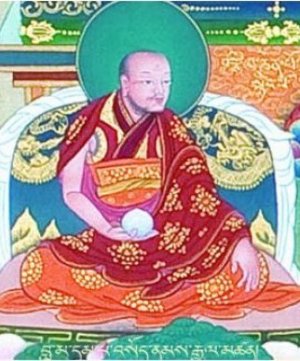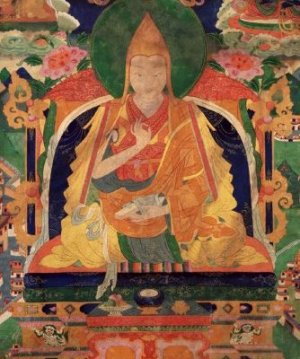| Library / Biographies |
Lahiri Mahasaya Biography

Lahiri Mahasaya had aversion to being photographed and attempts to capture his image yield blank space. This was allegedly the only time he accepted to pose, saying: "I am Spirit. Can your camera reflect the omnipresent Invisible?"Shyama Charan Lahiri (30 September 1828 – 26 September 1895), best known as Lahiri Mahasaya, was born into a Brahmin family in the Ghurni village (presently a neighborhood of Krishnanagar town) in Nadia district of Bengal Province. He was the youngest son of Muktakashi, wife of Gaur Mohan Lahiri.
His mother died when he was a child — there is very little known about her, except that she was a devotee of Lord Shiva. At the age of three or four, he was often seen sitting in meditation, with his body buried in the sand up to his neck.
When Lahiri was five, the family's ancestral home was lost in a flood, so the family moved to Varanasi, where he would spend most of his life.
As a child, he studied Urdu and Hindi, gradually moving on to Bengali, Sanskrit, Persian, French and English at the Government Sanskrit College, along with study of the Vedas. Reciting the Vedas, bathing in the Ganges, and worship were part of his daily routine.
In 1846, he was married to Śrīmatī Kāśi Moni. They had two sons and three daughters. His wife became his disciple. His work as an accountant in the Military Engineering Department of the British Indian government took him all over India.
After the death of his father, he took on the role of supporting the entire family in Varanasi.
In 1861, Lahiri was transferred to Ranikhet, in the foothills of the Himalayas. One day, while walking in the hills, he heard a voice calling to him. He met his Guru Mahavatar Babaji, who initiated him into the techniques of Kriyā Yoga1.
Absorbed in blissful samādhi (meditative absorption), he felt time, job, domestic life, all disappeared. He begged to remain at the feet of his Guru, but Babaji told him that the rest of his life was to be given to spreading the Kriyā message.
Soon after, Lahiri Mahasaya returned to Varanasi, where he began initiating sincere seekers into the path of Kriyā Yoga. He carefully graded Kriyā into four progressive initiations and bestowed the three higher techniques only after the devotee had manifested definite spiritual progress.
Over time, more and more people flocked to receive the teachings of Kriyā from Lahiri. To note his high spiritual state, his followers called him Mahasaya, which is a Sanskrit spiritual title translated as 'large-minded;' he was also popularly known as Yogiraj and Kashi Baba by his followers.
He organized many study groups and gave regular discourses on the Bhagavad Gita at his "Gita Assemblies." He freely gave Kriyā initiation to those of every faith, including Hindus, Muslims, and Christians, at a time when caste bigotry was very strong. He encouraged his students to adhere to the tenets of their own faith, adding the Kriyā techniques to what they already were practicing.
He continued his dual role of accountant and supporter to his family, and a teacher of Kriyā Yoga, until 1886, when he was able to retire on a pension. More and more visitors came to see him at this time. He seldom left his sitting room, available to all who sought his darshan2. He often exhibited the breathless state of superconscious samādhi.
Lahiri Mahasaya generally eschewed organized religion, but he allowed at least one advanced disciple, Panchanan Bhattacharya, to open the "Arya Mission Institution" in Kolkata to spread Kriyā teachings.
The Arya Mission published commentaries by Lahiri on the Bhagavad Gita, along with other spiritual books, including a Bengali translation of the Gita. Other disciples of Lahiri also started organizations to spread the Kriyā Yoga message, including Yukteswar Giri with his Satsanga Sabha.
Although Lahiri Mahasaya himself wrote no books, his penetrating interpretations were recorded and arranged by various disciples.
The central spiritual practice which he taught to his disciples was Kriyā Yoga, a series of inner pranayama practices. He taught this technique to all sincere seekers, regardless of their religious background.
Regarding Kriyā Yoga, he said: “Always remember that you belong to no one, and no one belongs to you. Reflect that someday you will suddenly have to leave everything in this world–so make the acquaintanceship of God now. Prepare yourself for the coming astral journey of death by daily riding in the balloon of God-perception. Through delusion you are perceiving yourself as a bundle of flesh and bones, which at best is a nest of troubles. Meditate unceasingly, that you may quickly behold yourself as the Infinite Essence, free from every form of misery. Cease being a prisoner of the body; using the secret key of Kriyā, learn to escape into Spirit.”
In 1895 he began letting some of his disciples know that he would soon be leaving the body. Moments before his passing, he said simply, "I am going home. Be comforted; I shall rise again." He then turned his body around three times, faced north, and consciously left his body, entering mahāsamādhi. Lahiri Mahasaya died on 26 September 1895, four days before turning 67. He was cremated according to Hindu Brahmin rites at Manikarnika Ghat in Varanasi.
Some of his notable disciples included:
• Panchanan Bhattacharya;
• Swami Sri Yukteswar Giri;
• Swami Pranabananda;
• Swami Keshavananda Brahmachari;
• Bhupendranath Sanyal
• Gyan Prabha Ghosh, mother of Paramahansa Yogananda;
• Bhagabati Charan Ghosh, father of Paramahansa Yogananda;
• Bhaskarananda Saraswati;
• Balananda Brahmachari;
• Maharaja Iswari Narayan Sinha Bahadur of Benares and his son.
Sources:
• https://en.wikipedia.org
• Autobiography of a Yogi, by Paramahansa Yogananda
• Yogiraj Shyama Charan Lahiri Mahasay, by Satyananda Giri
Footnotes
1. Kriyā Yoga is described as the ancient Yoga system revived in modern times by Mahavatar Babaji through his disciple Lahiri Mahasaya. Kriyā Yoga was brought to international awareness by Paramahansa Yogananda's book Autobiography of a Yogi and through Yogananda's introductions of the practice to the west from 1920.
2. Darśana (Sk.: dṛś, to see) is the auspicious sight of a deity or a holy person. The term also refers to six traditional schools of Hindu philosophy.





